高清详细的神经系统解剖学
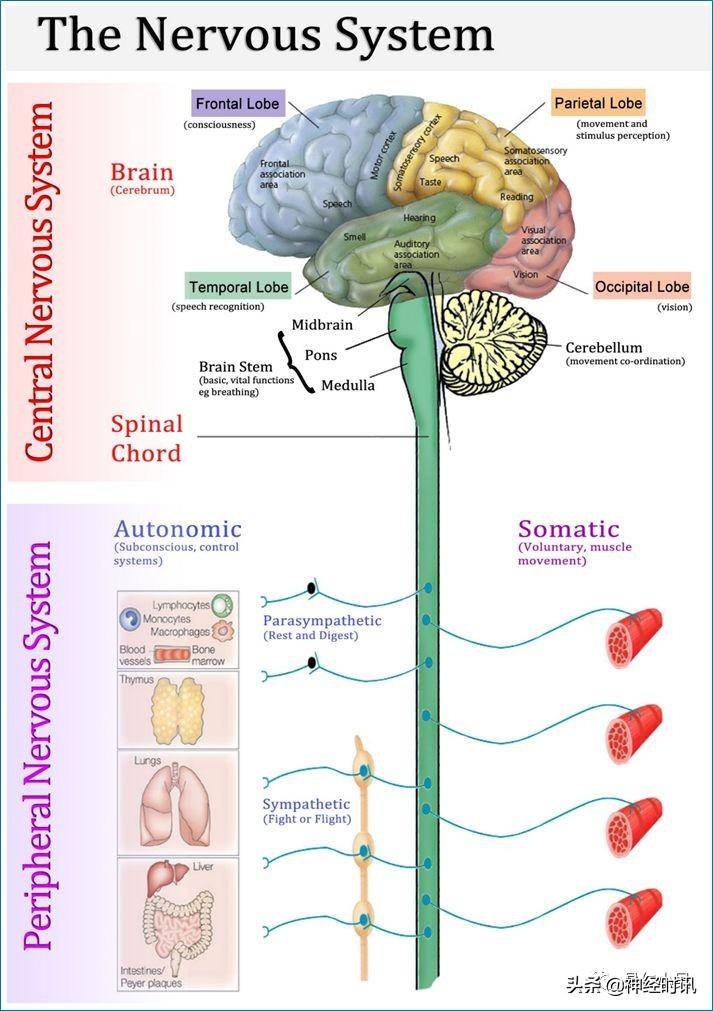
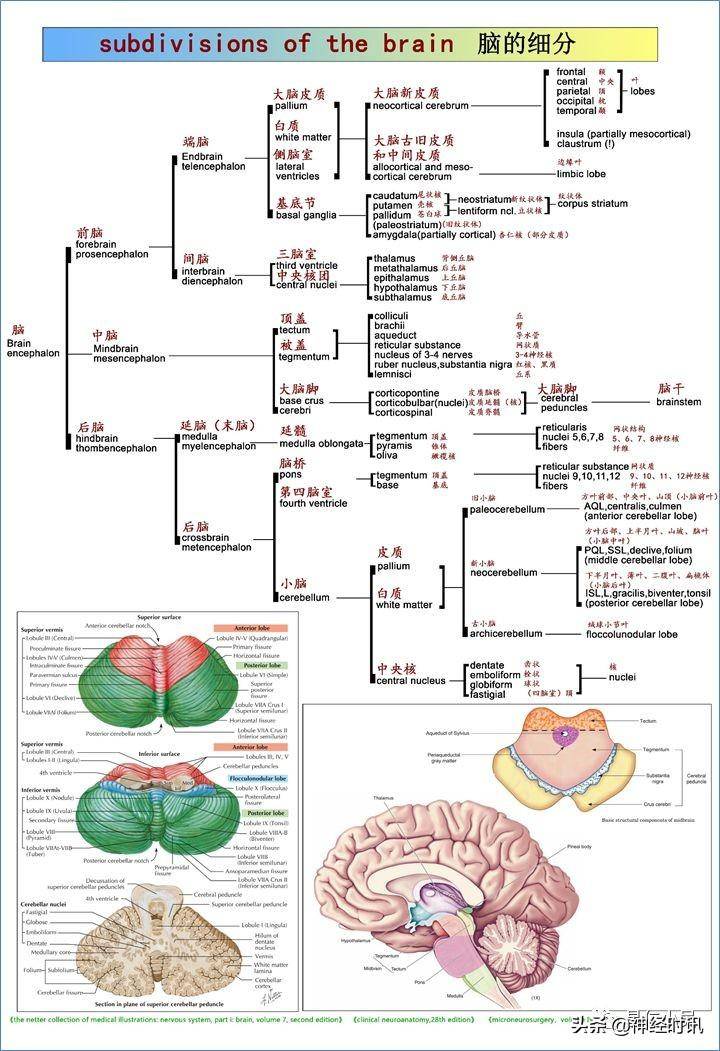
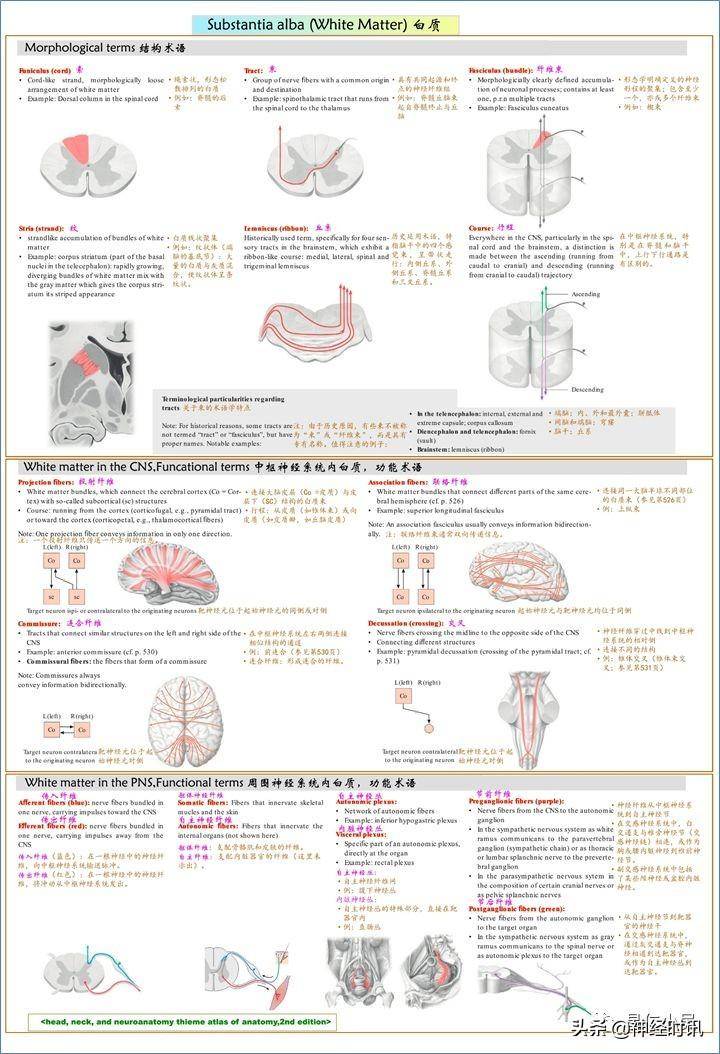
本次主要总结脑的解剖。思路如下:
1、脑可以简单理解为灰质(包括大脑皮质和基底神经核)和白质(投射、联络、连合纤维)组成。所以先学习 灰质结构 、 白质结构 及 灰白质与脑室系统的空间位置关系 。
2、大体解剖名词了解后再介绍皮层的 显微解剖 (细胞、皮质分层、在分层基础上的种类),了解大脑皮质的 种系发生 (新、中间、古、旧)。总体概况所有 大脑解剖结构 与 这四类皮质的对应关系 。
3、分系统{感觉、运动、语言(视、听、感觉)、边缘系统(内脏活动、情感、记忆)}来全面理解脑的功能与解剖结构之间的关系。
4、 神经外科手术定位知识点总结:在了解解剖、功能基础上,进一步深化学习头皮、颅骨、脑表面、中央核区、脑室解剖结构的对应关系。
5、 断层解剖。
目录:
一、灰质、白质、脑室解剖:
(一)脑表面解剖surface anatomy of brain:叶Lobe,沟/裂sulcus/fissure,回gyrus。
(二)大脑皮质下神经核团解剖(基底节+间脑+红核、黑质等)
(三)白质解剖:主要介绍联络、连合、投射纤维。
(四)脑室解剖:脑室与周围结构的关系
二、大脑皮质的种系发生介绍及功能分区方法:
(一)大脑皮层显微解剖介绍:细胞种类、皮质分层、种系分类以及每种类型皮质与具体解剖结构的对应关系。
(二)大脑皮质功能分区functional area:大脑功能分区一些名词概念解析,brodmann分区介绍,概况出4种类型(新/中间/古/旧皮质)对应解剖结构的功能。
三、功能系统:
(一)新皮质系统:中枢(感觉、运动、听、视、语言)和联络区。
(二)中间皮质和古旧皮质:边缘系统
四、断层解剖
一、灰质、白质、脑室解剖:
(一)表面解剖surface anatomy
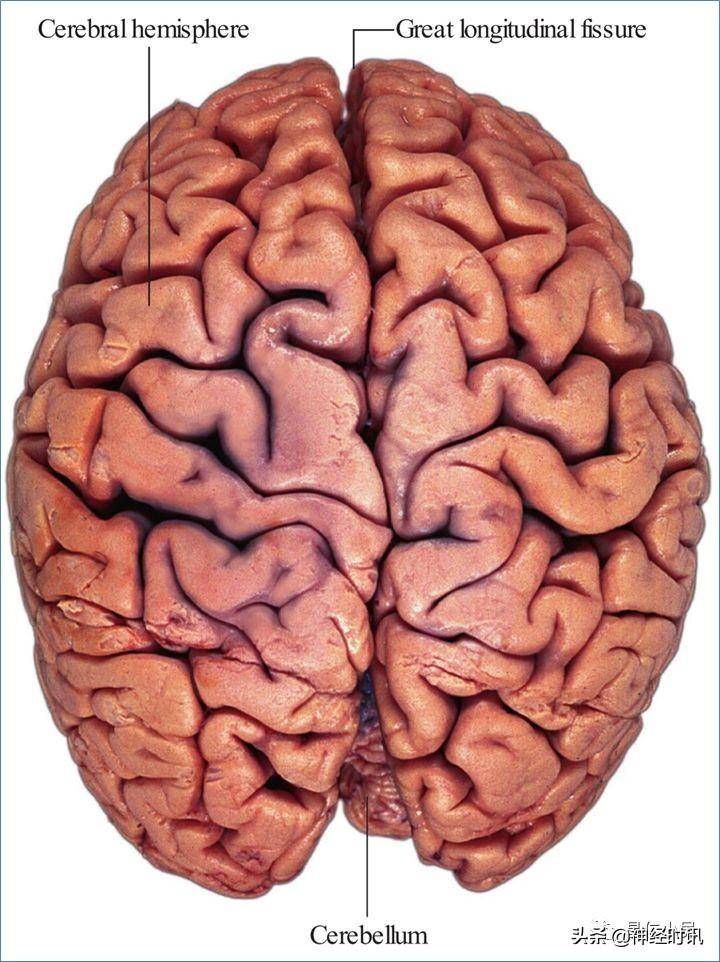
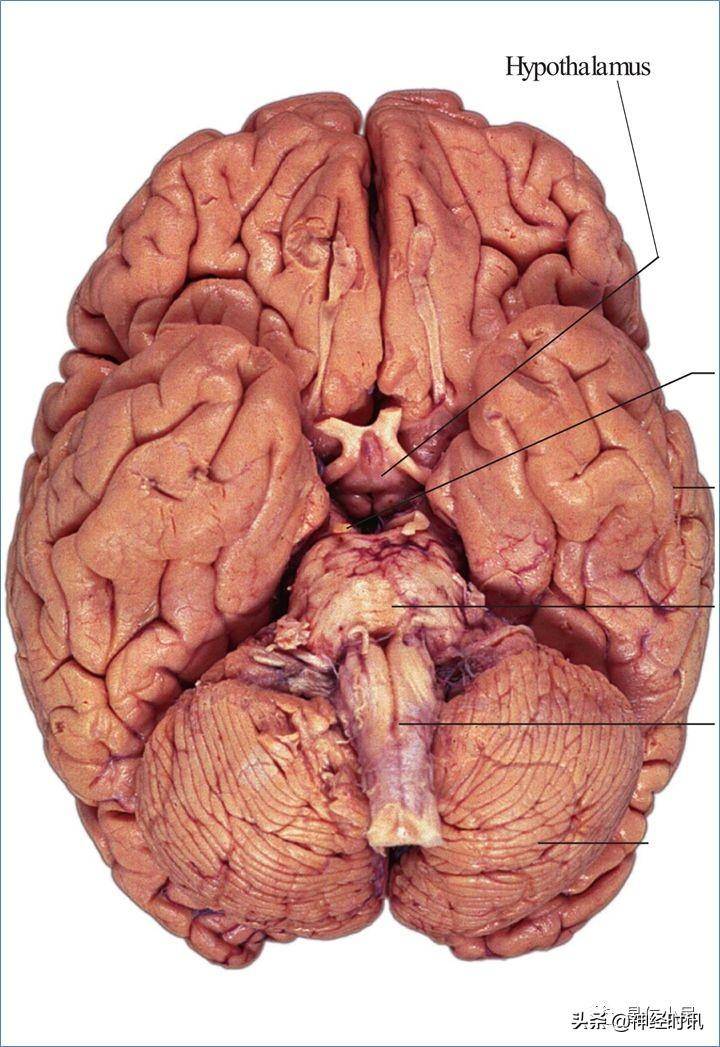

1、端脑telencephalon的边界 :
- 上内边 superiormedial border:为半球弯曲的上方界限,从额极到枕极将大脑凸面与内面分开。
- 上睫边 superiorborder:从额极到侧裂sylvian fissure起始处,将额叶外侧面与眶面分开。
- 下外边 inferiorlateral border:沿脑底外面的轮廓线,从颞叶到枕叶,将颞、枕叶与其底面分开。该边界线前部的向下突出对应颞叶与中颅窝的接触界面,后部的向上突起标志枕叶与小脑幕的接触界面。
- 眶内边 medialorbitalborder:将额叶内面与其眶面分开,为上内边向底面的连续,在额极与终板之间形成一直线。
- 枕内边 medialoccipitalborder:只有在脑干的尾端及小脑切除以后才能看得见。如在冠状切面中显示,这条有点圆滑的边位于大脑镰与小脑幕的夹角处,将枕叶的内侧面与其倾斜的底面分开。

2、大脑半球分叶lobe
Named Sulci and Gyri Cover the Cerebral Surface
Each a , ,, , and Lobe Motor Lobe Lobe Lobe Lobe Is with Other , Some inthe Lobe
3、大脑表面沟sulcus和回gyrus:
3.1、 额叶frontal lobe的脑回和脑沟
Øgyrus回:
- 背外侧面:Superiormiddleinferior(orbital riangularopercular)frontal gyrus额上中下(眶、三角、盖)回、precentralgyrus中央前回。
- 内侧及底面:anteriorparacentral gyrus旁中央小叶前半部、medial Superior frontal gyrus额上回内侧面;Rectus gyrus直回、orbital gyrus眶回。
Øsulcus沟:
- 背外侧面:Central sulcus中央沟、precentral sulcus中央前沟、superiorinferiorfrontal sulcus 额上中下沟、sylvian fissure侧裂。
- 内及底面:cingulatesulcus扣带沟、anteriorposterior parolfactory sulcus前后旁嗅沟、superiorinferior rostral sulcus嘴上下沟、olfactory groove嗅沟、orbital sulcus眶沟。
3.2、 顶叶 parietal lobule的脑回和脑沟:
Ø gyrus回:
- 外面:post central gyrus中央后回、superior parietal lobule顶上小叶、inferior parietal lobule(supramarginal gyrus and angular gyrus)顶下小叶(缘上回和角回)。
- 内面:precuneus楔前叶、posterior paracentral lobule旁中央小叶后半部。
Ø sulcus沟:
- 沟裂:Central sulcus中央沟、postcentral sulcus中央后沟、intraparietal sulcus 顶内沟、intermediate sulcus 中间沟、sylvian fissure侧裂、parietooccipital sulcus顶枕沟、anterior calcarinesulcus前距状沟、cingulate sulcus(marginal branch)扣带沟缘支、subparietalsulcus顶下沟。
- 假象线:Temporooccipitalline颞枕线、lateralparieto-temporal line外侧颞顶线。
3.3、 颞叶 temporal lobule的脑回和脑沟:
Ø gyrus回:
- 外面:superiormiddleinferior temporal gyrus颞上中下回{};
- 侧裂面:polar plane(real temporal operculum)极平面(真颞盖)、temporalplane颞平面——transverse temporal gyrus颞横回(Heschl gyrus is the most anterior of the transverse temporal gyri)(Heschl回是最前的颞横回){.};
- 下面:temporal pole颞极、occipito temporal (fusiform) gyrus枕颞回(梭状回){}、anterior lingual gyrus舌回前部.
Ø sulcus沟:
- 外侧面:sylvian fissure侧裂、lateral temporooccipital line外侧颞枕线、lateralparieto-temporal line外侧颞顶线、medial temporooccipital line内侧颞枕线、superior inferior temporal sulci颞上下沟、middle temporal sulcus(有时会有很短的颞中沟将颞中回分为上部和下部)。
- 内底:occipitotemporalsulcus枕颞沟、collateral sulcus侧副沟、rhinalsulcus鼻沟。
PPO:planumpolare(极平面);heg:Heschl gyrus;【冠状位片上看侧裂,在极平面处侧裂呈弧形,可见明显的岛盖;在出现颞横回的颞平面处侧裂呈水平状。所以极平面可以说是真正的岛盖,颞平面以及不构成岛盖。】
3.4、 枕叶 occipitallobule的脑回和脑沟:
Ø gyrus回:
- 外面:superiormiddleinferior(lateral)occipital gyri枕上、中、下(外侧)回;
- 内、底面:cuneus楔叶、lingual gyrus舌回、posterior occipito temporal (fusiform) gyrus枕颞回(梭状回)后部.
Ø sulcus沟:
- parietooccipital sulcus顶枕沟、calcarine sulcus距状沟、occipitotemporal sulcus枕颞沟;【顶枕沟上端与枕前切迹的假象连线为枕叶外侧面的前界;内侧面的前界为顶枕沟最前端与枕前切迹的假象连线。】【距状沟起自枕极,一直向前,距状沟在胼胝体压部后方以锐角加入到顶枕沟,继续向前,跨过半球下内缘,构成峡的下外侧缘,其连接扣带回与海马旁回】——摘自《格氏解剖学39版》
3.5、 边缘叶 limbic lobule的脑回与脑沟:
Ø gyrus回:
- subcallosal area胼胝体下区又称为paraolfactoryarea 旁嗅区 :(anterior paraolfactory sulcus前嗅旁沟与posteriorparaolfactory sulcus后嗅旁沟之间的区域);cingulate pole 扣带极 ;cingulate gyrus 扣带回 、isthmusofthecingulategyrus 扣带回峡部 、parahippocampalgyrus 海马旁回 、uncus 钩 、piriform梨形叶;
- diagonal gyrus斜角回( 胼胝体下回向下移行于斜带或斜角回,此回紧位于视束的前方,向外后方连于钩回 )、paraterminal gyrus 终板旁回 又称为infracallosalgyrus胼胝体下回;supracallosal gyrus胼胝体上回又称为indusium griseum 灰被 ;fasciolar gyrus 束状回 ;dentate gyrus 齿状回 ; hippocampal海马;fonix穹窿;mamillary eminence乳头体 。septal area 隔区 :(anterior paraolfactory sulcus前旁嗅沟与laminaterminalis终板之间的区域。)
Ø sulcus沟:
- 外围:cingulate sulcus扣带沟、subparietal sulcus顶下沟、anterior calcarine sulcus距状沟前段、collateral sulcus侧副沟、rhinalsulcus鼻沟(嗅脑沟)。
- 内外环分界:corpus callosum sulcus胼胝体沟、hippocampal sulcus海马沟、fimbrio-dentate sulcus伞齿沟、uncal notch钩切迹。
3.6、 岛叶 insula lobule的脑回与脑沟:
The forms the base of the and and lobes脑岛位于侧裂池的底部,在额叶和颞叶之间。
Øgyrus回:
- anteriormiddlepostshort insula gyrus前中后岛短回;
- anteriorpost long insulagyrus前后岛长回;
- transverse insular gyrus岛横回
Øsulcus沟:
- central insula sulcus岛中央沟
- anteriorsuperiorinferiorlimiting sulcus岛环沟(前上下界沟)
3.7、主要脑沟回重点讲解:
Ø沟、回概念、特点及所有脑回概括 :
- 沟是蛛网膜下隙的扩展和延伸,当其在脑表面加深并连续时构成沟。主要的沟深度达1-3cm,其壁上包含彼此相连的小沟回( 横向回 )。分隔回的沟长度和深度不同,通常连续的沟包括外侧沟lateral fissure、胼胝体沟callosal sulcus、距状沟calcarine sulcus、顶枕沟parieto-occipital sulcus、侧副沟collateralsulcus、中央沟centralsulcus。
- 大脑外伤面和下侧面的沟通常朝向最近的脑室腔隙。
- 大脑半球上外侧面:额叶和颞叶分别有3条水平的回(额上、中、下回)。中央区有2条轻度倾斜的中央前回和中央后回。顶叶区有2-3条不明确的回(上、中、下枕回)。岛叶位于外侧沟深部包括4-5条斜回(岛短回和岛长回)。
- 下面:眶部:由眶回和直回的基底部覆盖小脑幕部分:由颞叶下侧基底、枕下回和舌回以及梭状回覆盖。
- 内侧面:呈C形内环,通常有两条连续的回(cingulategyrusandparahippocampusgyrus),周围有尚未准确定义的外环回(直回和额上回内侧面、旁中央小叶、楔前叶、楔叶和舌叶内侧面)。
Ø侧裂sylvian fissure :是在大脑底面和外侧面的一条深裂,将上方的额叶和顶叶与下方的颞叶分隔开,分为浅部和深部,浅部在脑表面可见,深部通常称为侧裂池,岛叶是外侧裂池的底。
- 侧裂浅部包括1短干和3分支。短干:开始于下方的前穿质(anteriorperforated substance),在额叶眶面和颞叶前极之间向外延伸,内含蝶顶静脉窦。3分支:到达外侧面后,它分为前水平支(anteriorhorizontal ramus)、前升支(anterior ascending ramus)和后支(posterior ramus)。
- 侧裂池:分为蝶部sphenoidalpart和岛盖部operculoinsularcompartment。蝶部sphenoidalpart:在额叶和颞叶之间,由颈内动脉周围的脑池向外伸展。①顶壁:额叶眶面后部和前穿质,尾状核、豆状核及内囊前支位其上方;②底壁:极平面planumpolare的前部,为颞极上面没有脑回的区域,底壁的内侧部为钩回的前部(内含杏仁核)。③外侧缘:岛阈limen insular,为钩束uncinate fasciculus(连接额叶和颞叶之间的纤维束)表面的隆起。侧裂谷sylvian vallecula:有几种说法,个人理解为岛前沟,向外开口于岛阈。①《Rhoton-thecerebrum,P91》:The sylvian vallecula is the openingbetween the lips of the sylvian at the limen insula where the MCA turnsposteriorly to form the M2 segment.侧裂谷是侧裂唇之间在岛阈处的开口MCA在此向后转形成M2段。
②《 in ,P191》:The floor of the stem the ( ) which to the (APS).侧裂干底构成 岛前沟(侧裂谷) ,侧裂谷正对着前穿质。
③《 in ,P192》:The limen is the into the and forms limit of the .岛阈是进入岛叶的入口和侧裂谷的外侧界。
④《 ,P38》 , which in the of the the (APS), is space to ridge the lobes that the , also .侧裂蝶部 为岛阈外侧到前穿质(APS)之间的区域,是蝶骨嵴后方额叶和颞叶之间的狭窄空间,向内与颈动脉池相通,也称为 侧裂谷 。
岛盖部:由岛裂(分上下支)和盖裂两个狭窄的裂隙构成。
①岛裂:上支为额顶叶盖部与岛叶之间的裂隙;下支为颞盖与岛叶之间裂隙。
②盖裂:上唇(眶部、三角部、盖部、中央前回、中央后回、缘上回);下唇(颞平面planumtemporale和部分岛叶外侧的极平面)。
- The sylvian point:the site at whichthe last insular branch of middle cerebral artery turns laterally from theinsula, is located lateral to the posterior isthmus and the posterior part ofthe circular sulcus.侧裂点:大脑中动脉最后一个岛支从岛叶向外侧转出的部位,位于后峡部和环沟的后部。
Ø中央沟centralsulcus :又名Rolando裂或沟,它在两大脑半球内呈斜行走向,从头侧向足侧,沟深逐渐变浅,在最上层的大脑凸面可深达20cm,而在下部层面沟深约5mm。是额叶和顶叶的界限。始于上内缘或附近,在额极与枕极中点的稍后方。
- 迂曲向下向前行约8-10cm,止于外侧裂后支稍上方,与后支之间往往有一弓形的回相隔,其走向与正中面之间形成70°角,它区分分别位于中央前回和中央后回的皮质初级运动核躯体感觉区。
- 在CT或MRI上可通过以下5种方法辨认中央沟:
Ø距状沟calcarinesulcus :
- 起自枕极附近,虽然通常局限于内侧面,其后端却达外侧面;
- 一直向前,距状沟在胼胝体压部后方以锐角加入到顶枕沟;
- 继续向前,跨过半球下内缘,构成峡的下外侧缘,其连接扣带回与海马旁回。
距状沟很深,并产生一个隆起,即:禽距(calcaravis),位于侧脑室后角posteriorhornof lateral ventruicle壁。
- 距状沟始于胼胝体压部的前下方,沿着扣带回下部的下面先后走行,并绕过大脑半球内下缘先后走行。
- 距状沟前部被认为是完整沟,因为其很深,在侧脑室枕角的内壁产生一个隆起,即:禽距。
- 距状沟后部被认为是轴向沟,因为它的轴线沿着视觉皮层。只有后部包括主要的视觉皮质区,位于其上(楔叶)和下(舌叶)表面。距状沟后部经常隐藏着连接两个脑回的楔舌回。
- 距状沟前、后部之间为舌回,距状沟前部与枕钳之间为扣带回峡。距状沟后部后方为楔叶。
Ø 侧副沟collateralsulcus、枕颞沟occipitotemporalsulcus、嗅脑沟(鼻沟)rhinalsulcus:
- 侧副沟 起自枕极附近,向前与距状沟平行,两者间以舌回lingualgyrus分隔,侧副沟后方分开舌回和枕颞回,前方位于海马旁回和枕颞回之间。向前可与鼻沟rhinalsulcus相延续,但通常是分开的。侧副沟位于颞角的下方,向上深嵌入基底面形成 侧副隆起 ,位于颞角的底壁、海马的外侧。
- 鼻沟向前与侧副沟一起分隔颞极temporalpole和后内方的钩状结构——钩uncus。鼻沟为沿钩回外侧缘走行的一个短脑沟。嗅脑沟是梨形叶piriformlobe的外侧界。
- 在后方,侧副沟也向深部嵌入,在三角形的房部底壁形成一个隆起称为侧副三角。可通过打开侧副沟的深部从下方暴露颞角。
- 枕颞沟平行且位于侧副沟的外侧,将枕颞回和颞下回的基底面分开。
Ø 嘴上沟superior rostralsulcus与嘴下沟inferior rostral sulcus:
- 嘴上沟:位于大脑半球内侧面,为额上回内侧面和直回内侧面的分界。
- 嘴下沟:是直回内侧面中的一条短沟,有时缺如。
Ø 顶枕沟:为顶叶的后界,起自大脑半球的内侧面,于顶枕叶之间向外延伸至大脑外侧面。在MR图像上,顶枕沟常显示为大脑半球内侧部,胼胝体后方最深的一条脑沟,该沟前方为楔前叶,后方为楔叶。顶枕沟也是大脑前后动脉皮质支供血区的分界线。
Ø 半球内侧面,内缘及底面重要脑沟回的排布:
【 颞上中下回(T1、2、3)→枕颞沟→枕颞回(T4)→侧副沟和鼻沟→海马旁回和钩(T5),延伸至下托→海马(T6)→齿状回(T7)→伞。齿状回和海马伞分别位于海马的内侧面和上面,覆盖着海马。确切的说海马沟是下托与齿状回之间的沟。 】
Ø 关于海马旁回和钩回是否归属于颞叶,在本科《系统解剖学,第8版》教材P328是这样说的:
(二)大脑核心区cerebral central core神经核团解剖:
(三)白质解剖
The each of a core of white , which of nerve . The of white are three types 每侧大脑半球包含一个白质核心,它由有髓鞘神经纤维组成,这些白质纤维可以分为三种类型: ① 联络纤维 ,② 连合纤维 ,③ 投射纤维 。
1、 联络纤维
The parts of the of the same to each other. These are of two types. 联络纤维是把同一半球的大脑皮层的不同部分连接起来。它们有两种类型 :
Ø ,which the gyri to each other. 短联络纤维,它们联络相邻的脑回 。
Ø ,which the gyri at a from each other. 长联络纤维,它们联络彼此相距很远的脑回 。
- 扣带 The cingulum (girdle-shaped) is located within the cingulate gyrus. Itextends from the paraterminal gyrus to the uncus. The cingulum is part of the of the limbic system. 扣带(束带状)位于扣带回中。它从终板旁回延伸到钩。扣带是边缘系统的PAPEZ环路的一部分 。
- 钩束The uncinate fasciculus is a curved fibre bundle. It connects the inferior frontal gyrusand the orbital gyri of the frontal lobe to the hippocampus and amygdaloidnucleus of the temporal lobe. Thus, it connects the limbic areas of thecerebral hemispheres.钩束是一个弯曲的纤维束。它连接额叶的额下回和眶回与颞叶的海马和杏仁核。因而,它连接大脑半球的边缘区域。
- 上纵束 The superior longitudinalfasciculus is a long bundle that begins in thefrontal lobe and arches back via the parietal lobe to the occipital lobe, fromwhere it turns into the temporal lobe. Thus, it connects the occipital lobe tothe frontal eye field. (The arcuate fasciculus is a bundle of axons that forms part of the superiorlongitudinal fasciculus that connects temporal lobe and the frontal lobe. Thus,it connects the sensory and motor speech areas to each other in the dominanthemisphere). 上纵束是从额叶开始经顶叶弓背向后到枕叶和从顶叶弓背向后到颞叶的长束。因此,它连接枕叶与额眼动区。( 弓形束 是连接颞叶与额叶的一束轴突,是上纵束的一部分。因此,它在优势半球中使感觉性语言区和运动性语言区互相联络) 。
- 下纵束 The inferior longitudinalfasciculus connects the occipital lobe to the temporallobe. 下纵束连接着枕叶与颞叶 。
- 额枕束 The fronto-occipital fasciculus connects frontal to occipital and temporal lobes. It is lateralto caudate nucleus, lies medial to the superior longitudinalfasciculus and is separated from it by corona radiata. 额枕束连接着额叶与枕叶和颞叶。额枕束位于尾状核的外侧上纵束的内侧,并由放射冠将额枕束与上纵束分开 。
- 垂直束 The perpendicular fasciculus connects the parietal lobe to the occipital lobe and theposterior part of temporal lobe. 垂直束连接着顶叶与枕叶和颞叶后部 。
2、连合纤维commissural
Ø The the and parts of the . Note: All from one side of the brain or to the side are not . When a mass of grey in of the (CNS) end other mass of grey in the half, they are to , and the sites where such take place are as . 连合纤维穿过中线并连接两个半球的功能上相同的部分。注意:所有从大脑或脊髓一侧向相反侧交叉的纤维不是连合纤维。当起源于中枢神经系统(CNS)的一半的灰质团中的纤维束终止于另一半的灰质团时,它们被称为交叉纤维束,并且发生这种交叉的部位称为纤维束交叉 。
ØImportant Commissures重要的连合纤维 :
- 胼胝体 The corpus callosum is the largest commissure of the brain connecting various partsof neocortex of both the hemispheres. 胼胝体是连接两侧大脑半球新皮质不同部位的最大的连合纤维 。
- 前连合 The anterior commissure connects the right and left temporal lobes. It is in the shapeof a cupid’s bow. It crosses the midline in the upper part of the laminaterminalis anterior to the columns of fornix. 前连合连接着左右颞叶。其状如“丘比特弓”。它在穹窿柱的前方穿过终板上部的中线 。
- 缰连合 The habenular commissure is located in the superior lamella of the pineal stalk and is apart of epithalamus. It connects the habenular nuclei of both sides. 缰核连合位于松果体的上板层,是上丘脑的一部分。它连接着两侧的缰核 。
- 后连合 The posterior commissure is located in the inferior lamella of the pineal stalk and is apart of brainstem. It connects the nuclei of III, IV, VI and VIII cranialnerves. 后连合位于松果体的下板层,是脑干的一部分。它连接了III、IV、VI和VIII颅神经的神经核 。
- 海马连合或穹窿连合 The hippocampal commissure or commissure of fornix connects the hippocampus of the two sides to each other. 海马连合/穹窿连合连接着两侧的海马 。
3、投射纤维projection
Ø The the to other CNS below it by or and or . 投射纤维通过到达皮质的上行纤维和离开皮质的下行纤维来连接大脑皮质与中枢神经系统的其他区域 。
Ø Projection Fibre Bundles 投射纤维束 :
- 辐射冠 The corona radiata (Figure 11.7) is a mass of white matter composed of theprojection fibres, which converge from the cerebral cortex to the internalcapsule and fan out from the internal capsule toward the cortex. 辐射冠(图11.7)是由投射纤维组成的白质团,从大脑皮层向内囊汇聚,从内囊向皮质扇出 。
- 内囊 The internal capsule (Figures 11.6 and 11.7) transmits the corticofugal projectionfibres like corticospinal, corticonuclear and corticopontine fibres. Thesefibres arise in the cerebral cortex and terminate on the lower neurons (likeanterior horn cells, cranial nerve nuclei in brainstem and pontine nuclei). Theinternal capsule also gives passage to corticopetal thalamic radiations(comprising of connections between cerebral cortex and thalamic nuclei). 内囊(图11.6和11.7)传递离皮质投射纤维,如皮质脊髓、皮质核和皮质桥脑神经纤维。这些纤维产生于大脑皮层,终止于下层神经元(如前角细胞、脑干的颅神经核和脑桥核)。内囊还有向皮质的丘脑辐射(包括大脑皮层和丘脑核之间的连接)通过 。
These to form to form the crus of the . Most of these the the and to form a thick sheet of the . 这些纤维呈扇形扇出,形成放射冠,尾部致密形成中脑的大脑脚。这些纤维大部分通过内侧的丘脑和尾状核与外侧的豆状核之间的间隙,形成一个称为内囊的厚纤维片 。
上行纤维( 向皮质纤维): These are s , which go from the to all parts of the ( 11.10 and 11.11). 这些主要是丘脑皮质纤维,从丘脑到大脑皮质的所有部分(图11.10和11.11) :
- Anterior thalamic radiation :Fibres to the frontal lobe constitute the anterior thalamic radiation. They passthrough the anterior limb of the internal capsule. The fibres arise mainly fromthe medial and anterior nuclei of the thalamus. The anterior thalamic radiationalso carries fibres from the hypothalamus and limbic structures to the frontalcortex. 丘脑前辐射 :到额叶的纤维构成丘脑前辐射。它们穿过内囊的前肢。这些纤维主要来自丘脑的内侧核和前核。丘脑前辐射还携带下丘脑和边缘结构的纤维到额叶皮质 。
- Superior thalamic radiation :Fibres travelling from the ventral group of nuclei (ventral anterior, ventrallateral, ventral posteromedial and ventral posterolateral) of the thalamus tothe somatomotor and somatosensory areas constitute the superior thalamicradiation. These fibres occupy the genu and posterior limb of the capsule. Itshould be noted that these fibres are third-order sensory neurons responsiblefor conveying somaesthetic sensations to the cerebral cortex. 丘脑上部辐射 :从丘脑腹侧核群(腹前部、腹外侧、腹后内侧和腹后外侧)到躯体运动区和躯体感觉区的纤维构成丘脑上部辐射。这些纤维占据内囊的膝部和后肢。应当指出,这些纤维是负责将躯体感觉传送到大脑皮层的三级感觉神经元 。
- Posterior thalamic radiation :Fibres from the thalamus to the occipital lobe constitute the posterior thalamicradiation. This includes the optic radiation from the lateral geniculate body to the visual cortex. Theseradiations lie in the retrolentiform part of the internal capsule. Theretrolentiform part also contains some fibres passing from the thalamus to theposterior part of the parietal lobe. Figure 11.11: Fibres and tracts that pass through the various parts ofinternal capsule (: H- Head and neck; U - Upper limb; T - Trunk; L - Lower limb). 丘脑后辐射 :丘脑至枕叶的纤维构成丘脑后辐射。这包括从外侧膝状体到视觉皮层的视辐射。这些辐射位于内囊的豆状核后部。内囊的豆状核后部还含有从丘脑到顶叶后部的一些纤维。图11.11:穿过内囊各个部分的纤维和束(缩写:H-头和颈;U-上肢;T-躯干;L-下肢) 。
- Inferior thalamic radiation :Fibres from the thalamus to the temporal lobe constitute the inferior thalamic radiation.It includes the auditory radiation from the medial geniculate body to the auditory area of thecerebral cortex. These fibres pass through the sublentiform part of theinternal capsule. 丘脑下辐射 :从丘脑到颞叶的纤维构成丘脑下丘脑辐射。它包括从内侧膝状体到大脑皮层听觉区的听觉辐射。这些纤维穿过内囊的豆状核下部 。
DESCENDING FIBRES 下行纤维(CORTICOFUGAL FIBRES离皮质纤维) (FIGURE 11.11):
- Corticopontine fibres :They originate from all four lobes of cerebral cortex and are named accordingto the lobe from which they arise: 皮质脑桥纤维 :它们起源于大脑皮层的所有四个叶,根据发出它们的脑叶来命名 : ①Frontopontine fibres accountfor 55% of corticopontine fibres. Therefore, they pass through the anteriorlimb, genu and posterior limb of the internal capsule. 额脑桥纤维 占皮质脑桥纤维的55%。因此,它们通过内囊的前肢、膝部和后肢 。 ②Parietopontine fibres passmainly through the retrolentiform part. Some fibres pass through the sublentiformpart. 顶脑桥纤维 主要通过内囊的豆状核后部。一些纤维穿过内囊豆状核下部 。 ③Temporopontine fibres passthrough the sublentiform part (Figure 11.12). 颞脑桥纤维 穿过内囊的豆状核下部(图11.12) 。 ④Occipitopontine fibres passthrough the retrolentiform part. 枕脑桥纤维 穿过内囊的豆状核后部 。
- Pyramidal fibres 锥体纤维 (corticospinal andcorticonuclear fibres 皮质脊髓和皮质核纤维 ) : ①Corticonuclear fibres (formotor cranial nerve nuclei) pass through the genu of the internal capsule. 皮质核纤维 (到运动性颅神经核)穿过内囊的膝部 。 ②Corticospinal fibres formseveral discrete bundles in the posterior limb of the capsule. The fibres for theupper limb are most anterior followed (in that order) by fibres for the trunkand lower limb. 皮质脊髓纤维 在内囊的后肢形成若干离散束。支配上肢的纤维在最前部,随后为支配躯干和下肢的纤维(按顺序排列) 。
- Corticothalamic fibres :Tese pass from various parts of the cerebral cortex to the thalamus. They formpart of the thalamic radiations described above. 皮质丘脑纤维 :皮质从大脑皮层的各个部分传递到丘脑。它们形成了上述丘脑辐射的各个部分 。
- Extrapyramidal fibres 锥体外系纤维 : ①Corticostriate fibres originatingfrom all parts of cerebral cortex and terminating in caudate nucleus andputamen. 皮质纹状体纤维 发自于大脑皮质的所有部分,终止于尾状核和壳核 。② Corticorubral fibres originatingfrom the motor areas of the frontal lobe and terminating in the red nucleus. 皮质红核纤维 发自于额叶运动区并终止于红核 。 ③ Corticoreticular fibres beginningfrom the motor cortex and the parietal lobe and terminating in reticularnuclei. A summary of the various ascending and descending fibres passingthrough different parts of internal capsule are given in Table 11.1. 皮质网状纤维 发自于运动皮质和顶叶,终止于网状核。表11.1给出了通过内囊不同部分的各种上行和下行纤维的概要 。
- 外囊 The external capsule is a bundle of fibres, which lies lateral to putamen oflentiform nucleus and contains corticostriate fibres. 外囊是一束纤维,位于豆状核的壳核外侧并含有皮质纹状体纤维 。
- 穹窿 The fornix is composed of projection fibres,commissural fibres and association fibres , which take originfrom the hippocampus. The projection fibres in the fornix are connected to theneurons of the mamillary body of hypothalamus. The commissural fibres of fornixcross beneath the splenium to the opposite side fornix and end in the hippocampusof opposite side. The association fibres in the fornix connect the hippocampuswith the neighboring parahippocampal gyrus and septal areas. 穹窿由投射纤维、连合纤维和联络纤维组成,起自海马。穹窿中的投射纤维连接到下丘脑的乳头体的神经元。穹窿连合纤维在胼胝体压部的下方与对侧穹窿交叉,终止于对侧海马。穹窿内的联络纤维连接海马与邻近的海马旁回和隔区 。
(四)脑室解剖
其他图请点链接 脑室到底在哪里?
二、大脑皮质的种系发生介绍及功能分区方法:
(一)大脑皮质显微解剖:
1、大脑皮质结构cerebral cortex structure:
Ø Cell types:人类皮质的 神经细胞 约140亿,主要有三种类型:
- 锥体细胞 pyramidalcells:是皮质细胞中最典型的,依胞体大小分为大、中、小三类。
- 星形细胞 (颗粒细胞):多为小型细胞,呈多角形或三角形。
- 梭形细胞 (多形细胞):主要见于皮质深层。
Ø Laminar organisation 层状组织:
- 从大脑皮质的任何部位切片均可见神经元的层层排列结构,皮质细胞构筑的显着特征是分层。由于皮层各部的功能不同,每层神经细胞的形态、大小和排列的密度也有差别。大部分皮质都可分为六个基本层次:分子层(丛状层)molecularlayer:由大量神经纤维组成,以水平细胞为主。外颗粒层(小锥体细胞层)externalgranular layer:颗粒细胞排列密集而得名。外椎体细胞层externalgranular layer:中小锥体细胞组成。占皮质厚度的1/3。内颗粒层internal granularlayer:大量星形细胞和散在小锥体细胞。节细胞层(内锥体细胞层)ganglioniclayer(internal pyramidal layer):以大型锥体细胞为主。多形层(多形细胞层)multiformlayer(layer of polymorphic cells):因含有多种类型的细胞而得名。
2、大脑皮层的种系发生:
Ø关于古皮质、旧皮质翻译问题的文摘:
The be into (“paleo”) , old (“archi”) and new(“neo”) parts (see D). the with of white is the , a term with“”. 大脑半球在种系发生上可分为古(“paleo”)、旧(“archi”)和新(“neo”)部分(见D)。大脑皮层和底面白质相关区域被称为,这个术语有时可以与“”互换使用。
(); (old part); ( part).
——摘自《 Thieme atlas ofanatomy head and neuroanatomy 2010,P19899 》
——摘自《Duus’s topical diagnosis in neurology,5 ed, P225》
Ø TYPES OF CORTEX 皮质类型
The allocortex consists of archicortex and paleocortex.
Archicortex(古皮质)
The of the most 古皮层为种系发生学上最古老的大脑皮层。 The of the most . of only three cell : a layer, a layer, anda layer. The is only in the . This type of is with the , which in and the of .古皮质为种系发生学上最古老的大脑皮质。它由三个细胞层组成:多形细胞层,锥体层和分子层。古皮质仅位于 海马结构 。这种皮质与边缘系统有关,它涉及记忆过程和情绪表达。 (旧皮质)
, after the 在种系发生学上,旧皮质形成于古皮质之后。 , the after the , and of three to five cell .It is found in the (the , ofthe gyrus, half of the uncus, and ) and the , which the of the gyrus. It the sense of smell, and be in the of .在系统发育上,旧皮质形成于古皮质之后,它由3至5个细胞层组成。它存在于 初级嗅皮质 (梨状皮质,由外侧嗅回、钩前部和杏仁核皮质组成) 和 次级嗅皮质 ,其中包括海马旁回的 内嗅皮质 。它可以调节嗅觉,也可以参与情感的处理。
The is a the older newer 中皮质是旧的异生皮层和新的同生皮质之间的过渡皮质。
The () is a and . It of three to six , and is found inthe gyrus and the .中皮质是旧的异生皮层和新的同生皮质之间的过渡皮质。它由3到6层组成,存在于 扣带回 和 脑岛 。
In , the first four (I–IV) of the input ( ), the (V and VI) are a major of () 一般来说,大脑皮层的前四层(I-IV)充当输入站(接收向皮质的纤维),而其余的层(V和VI)是输出(离来皮质的)投射纤维的主要来源。 The six cell . In to being named, its cell are with Roman (I–VI) in the order that they from deep, that is, from deep to the pia mater to the (Fig. 25.3).新皮质由六个细胞层组成。除了命名之外,它的细胞层还按罗马数字(I-VI)顺序编号,顺序是从表层到深层,即直接从软脑膜深入到皮层下白质。 the of six , each of these is in all areas. In the motor , II–V avast of large cells whose axons leave the , and in to lower in the , , , basis , and of the to inthe and cord. () cells, on the other hand,are not as in these of the motor . Due to this , the motor is to as . is of the motor areas that by cells.虽然新皮质由六层组成,但在所有皮质区都不易区分每一层。在运动皮层,II-V层包含大量的大型锥体细胞,其轴突离开皮层,并下降到辐射冠、内囊、大脑脚、桥脑基底部和延髓锥体中的下位中枢,终止于脑干和脊髓。另一方面,非锥体细胞(颗粒)细胞在运动皮质的这些层中并不多。由于这种形态学特征,运动皮质被称为无颗粒皮质。粒细胞皮质是典型的皮质运动区,由锥体细胞大量填充。 the motor , the small cells, and is () cells. These cells give the of the areas a , so it is to as .与运动皮质不同的是,初级感觉皮质包含小的锥体细胞,并由大量的非锥体(颗粒)细胞组成。这些细胞使初级感觉区域的皮层呈现颗粒状外观,因此被称为颗粒状皮质。In , the first four (I–IV) of the serve as , , the (V and VI) are a major .一般来说,大脑皮层的前四层(I-IV)充当输入站(接收向皮质的纤维),而其余的层(V和VI)是输出(离来皮质的)投射纤维的主要来源。
Ø 传入传出纤维Afferents andEfferents:在皮质细胞构筑中,有皮质神经元间构成局部回路的皮质-皮质纤维,还有垂直走行于大脑皮质的传出与传入纤维。
- 皮质传出纤维:第V、VI层锥体细胞和梭形细胞的轴突组成的皮质下各种纤维束。
- 皮质传入纤维:
① 特异性传入纤维:来自丘脑腹后核(至感觉皮质)或腹外侧核(至运动皮质)。
② 非特异性传入纤维:来自丘脑中线核、板内核群。
③ 皮质-皮质纤维:包括联络纤维和连合纤维两种。
a) 联络纤维:同侧皮质第III层浅部和部分第Ⅱ层的神经元之间。
b) 连合纤维commissural:对侧同型皮质第III层的锥体细胞之间。
(二)大脑皮层功能分区functional areasof cerebral cortex:
1、大脑皮质功能定位相关概念解析:
Ø 根据大脑皮质的结构与功能,将其分为躯体运动、躯体感觉、视觉和听觉等区, 功能相对明确 的部位称为 中枢 center,功能相对不明确的称为 哑区 silentarea。各功能的主要投射部位为 中心区 ,其周围的皮质称为 边周区 。边周区与中心区结构相似,功能也受其控制。
Ø 各边周区之间的脑区称 联络区 。它们多集中在额叶前部,顶、枕叶的中部和颞叶的中、下部等处。在种系发生上联络区是晚出现的,在人脑极为广阔,联系广泛,一般认为是高级的皮质,它们 不局限于某种功能 ,而是完成高级的神经精神活动。联络区在高等动物显着增加。
- 额叶的联络区:功能与躯体运动、发音、语言及高级思维运动有关。
- 顶叶的联络区:功能与躯体感觉、味觉、语言等有关。
- 枕叶的联络区:功能与视觉信息的整合有关。
- 颞叶的联络区:功能与听觉、语言和记忆功能有关。
- 边缘叶与内脏活动有关。
Ø 由于皮质各区的构造不同,所以功能也不相同,一般以中央沟为界,其前部多关系运动功能,中央沟后部属接受区(躯体感觉、视觉、听觉等)。但运动和感觉关系密切,难以截然分开,一般沿用功能上以运动为主的皮质称为 运动区 ,以感觉为主的皮质称为 感觉区 。因此 。 到目前为止,人们只掌握一些一般的功能(如运动、感觉等)障碍的定位,而较复杂的、种系发生上出现较晚的皮质功能,如思维和意识等,则难以确切定位 。
Ø 大脑的不对称性及优势半球:右利手者的左大脑半球主管语言文字、数学技巧和分析思维,右半球与非语言功能有关,主管音乐、图形、情绪、时空概念以及整体思维。但这种不对称性也是相对的。女性脑功能不对称性不如男性明显。不对称可能还表现在对免疫、内分泌等功能的调节方面。
Ø 靠前感觉区或靠前运动区中所谓的“靠前”,其命名仅是根据发现的时间次序,不意味着有特殊的或突出的功能意义。《神经解剖学,第2版,朱长庚主编》P521,523:
Ø 大脑皮质的分级( Luria根据功能分 ):
- 一级区 (初级功能区):包括初级感觉和初级运动皮质
- 初级感觉:
- 靠前躯体感觉区:Brodmann3、1、2区
- 靠前视区:Brodmann17区
- 靠前听区:Brodmann41、42区
- 初级运动:靠前运动区:Brodmann4区
- 二级区 (较高级的功能区):包括较高级的感觉皮质区和较高级的运动皮质区:
- 较高级的感觉皮质区:
- 第二躯体感觉区:Brodmann2区。
- 第二视区:Brodmann18区。
- 第III、IIIa、IV、V视区:枕叶和颞上沟附近,Brodmann19区和19区前方。
- 视下颞区:颞叶前部和下部,Brodmann21、20区。
- 顶后皮质区(躯体感觉和视觉):顶上小叶,Brodmann20区。
- 较高级的运动皮质区:
- 运动前区:Brodmann6区
- 辅助运动区:Brodmann8区
- 三级区 (高级的功能区):既往称为哑区或静区,现代称为联络(联合)区或联合皮质。 现在知道这些区域正是皮质功能*高级的部位。它们分别主理一个以上的感觉活动的综合和运动前的策划,人类思维即起源于此 。它们的功能不是孤立的,有赖于初级、较高级部位的联系,但它们在人类思维活动过程中的主导地位是毋庸置疑的。 因为它们似乎无特定的基本功能,在脑外科中早年甚至现在常被忽视,常遭不必要的损毁,这实在是不应有的 。——《临床神经解剖学第2版,P449》。
- 顶-颞-枕联合区 :此区综合多种感觉功能,其中包括躯体感觉、视觉、听觉,并在此上升为意识。此区与语言、记忆关系尤为密切,本区为人类所特有,近7岁才渐趋成熟。
- 前额联合区 :占额叶背外侧面的前部,6区之前的广大区域。参与多种高级心理活动(注意力调控、空间记忆、性格、情感、社会行为调控等)。人类左侧前额联合区(45区)还与运动性语言功能有关。
- 边缘联合区 :位于额叶腹内侧面、顶叶内侧面和颞叶前端(颞极)。相当于23、24、38、28区和11区。又可分为眶额皮质、扣带回和海马旁回三个亚区。边缘联合区接受其他广大感觉皮质区的投射,并转而投射到其他皮质区。
- 眶额皮质(额叶眶部)和扣带回前部与情感行为有关。
- 颞叶前部,特别是海马和海马旁回与记忆有关。左侧偏向于词语记忆,如事物的名称;右侧偏向于非词语性记忆,如不规则的线条图形,特别是人的面部辨认和记忆。海马与记忆相关是十分肯定的,尤其是近期记忆。
2、Brodmann area:
三、功能系统: 从皮层种系上分新旧皮质来理解大脑皮质功能 。新皮质功能区=中枢(特定功能的区域)+联络区;古旧皮质功能区=边缘系统。
(一)新皮质系统:中枢(感觉、运动、听、视、语言)和联络区。
1、中央沟以前:主要与运动功能、说话功能相关
2、中央沟以后:主要与感觉功能有关
3、外侧裂以下多与听觉、味觉、语言理解等有关
4、枕叶及顶颞叶与枕叶交界处均与视觉功能相关。
(一)古旧及中间皮质系统:
1、边缘系统介绍:
边缘系统是指高等脊椎动物中枢神经系统中由 古皮层、旧皮层 演化成的大脑组织以及和这些组织有密切联系的 神经结构 和 核团 的总称。古皮层和旧皮层是被新皮层分隔开的基础结构{主要包括:海马结构(海马、齿状回、下托复合体)、扣带回、峡、海马旁回、钩、内嗅区、乳头体以及杏仁核,上述结构通过帕帕兹环[Papez环路]相互联系,并与其他脑结构(新皮层、丘脑、脑干)有广泛联系。}故 将边缘叶与其结构和功能相近的皮质和皮质下结构统称为边缘系统 。
所以边缘系统的作用是使 中脑 、 间脑 和 新皮层结构 之间发生信息交换。通过与下丘脑及植物神经系统的联系,边缘系统参与调解本能和情感行为,其作用是自身生存和物种延续。此外,海马结构还对学习过程和记忆发挥着突出的作用。因此如果海马结构或与之功能联系的结构受损,则导致遗忘综合征。其病变部位不同,产生的记忆障碍形式也不同。
Ø 边缘叶定义:边缘叶在大脑半球内侧面,包括扣带回、海马旁回、海马、齿状回等结构, 围绕脑干上端和胼胝体周围,呈环状 。边缘叶位于大脑半球的内侧面,呈环形包绕大脑半球颈的周围。
- 其 外界 是扣带沟、顶下沟、距状沟的前部和侧副沟;其 内界 是胼胝体的上面和脉络膜裂。
- 边缘叶又以 胼胝体沟 和 海马沟 分为内、外二带形区。胼胝体沟始自胼胝体嘴的腹侧,沿胼胝体背侧后进,最后绕到胼胝体压部的下方,移行于海马沟。海马沟始自胼胝体压部的下方,然后向颞极前进,终于海马回钩。 边缘叶外带:又称穹窿回,此回又分三部, ①扣带回 ,位于胼胝体沟和扣带沟之间; 峡 位于胼胝体沟与距状沟前部之间; ②海马旁回 ,位于侧副裂和海马裂之间,此回的前端绕过海马裂的前端,形成海马回 钩 。③在胼胝体下区前部,有一个折叠连接着直回和扣带回的基底部,并围绕嘴上沟后端,此折叠称为 扣带极cingulate pole 。边缘叶内带:也由数部组成,在胼胝体背面盖有薄层灰质,此灰质被走行在每个扣带回下方的内、外侧纵纹所覆盖,称其为 胼胝体上回(灰被)。 ①在胼胝体沟底灰被移行于 扣带回 ; ②灰被向前绕到胼胝体嘴的下方,移行于终板前方的 胼胝体下回 ( 终板旁回 )【终板旁回的前界为后旁嗅沟,此沟的前方有一并行的短沟,称前旁嗅沟。二沟之间的部分,称旁嗅区。胼胝体下回向下移行于 斜角回 ,此回紧位于视束的前方,向外后方连于 海马回钩】 ; ③胼胝体上回向后,绕过胼胝体压部,移行于 束状回 【而束状回再向前下方,则移行于海马及 齿状回】 。
- 钩:是海马旁回的前端,在小脑幕缘的上方突向内侧,为前穿质的后外缘,是嗅觉系统梨形叶的一部分,后者在系统发育上为大脑皮质最古老的部分之一。海马旁回以 鼻沟(或叫嗅脑沟rhinalsulcus) 与突向内侧的钩回分开。
钩回从上面或下面观察时,呈角状,其前段和后段汇合于内侧的尖端。钩回的尖端为前后段的汇合点,指向内侧的动眼神经和后交通动脉。
钩回前段:前段内侧面连续,内侧面面对外侧裂的近端、颈动脉池以及颈内动脉和大脑中动脉近端。 杏仁核 构成钩回前段的绝大部分,并到达前段上部的内侧面。杏仁核可认为完全位于钩回界线内,它构成侧脑室颞角的前壁,向上与屏状核和苍白球相融合,二者之间没有明确界限。
钩回后段:其内侧面被钩回切迹uncalnotch分为上部和下部,钩回切迹为一短的脑沟,从后方伸入钩回内侧面的后段。后段面对大脑脚,并和大脑脚共同构成脚池的外侧壁和内侧壁,池内有大脑后动脉、脉络膜前动脉和脉络膜后内测动脉穿行。视束位于钩回后段内侧缘上方的脚池顶壁。后段的上部主要由 海马头部 的内侧面构成。钩回后段由数个与齿状回相延续的小脑回构成。下脉络点是有脉络丛附着的脉络裂下端,恰位于钩回后段上缘的后方,紧靠海马头部的后方,是脉络膜前动脉穿经脉络裂进入颞角的位置。
在脑室内有一个突向内侧的间隙称为钩回隐窝,位于钩回尖端外侧的杏仁核脑室面和海马头部之间。
- 海马结构:包括齿状回、海马、下托复合体和内嗅皮质。
- 海马:
- 海马的由来与定义:最初(1587)有人因为从侧脑室颞角观看时发现有这么一条突起样结构,起名为“ seahorse ”(中文“海马”,拉丁文“ hippocampus ”),后来又有人发挥想象力将其比喻成一种神话传说中的号角( cornuAmmonis ,中文“Ammons 角”)。期间又有人将其命名为“ pes hippocampi major ”(中文“大海马足”),而将侧脑室后方另一突起结构命名为“ pes hippocampi minor ”(中文“小海马足”)。而随着“pes hippocampi minor”在1895年时被废除即成为现在所说的“calcar avis”(中文“禽距”,即距状沟向枕角内的突出,也称“距状隆起”),“pes hippocampi major”也被更名为“ pes hippocampi ”且更改了涵义。现在,“hippocampus”或“ hippocampus proper ”(海马,proper是本身的意思)仍是指侧脑室颞角内的隆起,其位于齿状回(dentategyrus)外侧。“hippocampal formation”(HF,海马结构)则等于hippocampus+dentate gyrus。“ pes hippocampi ”(海马足)则指海马头部( head of hippocampus ,海马分为头部、体部、尾部),原因在于其表面有数条像猫足爪样的浅沟。随着组织学的研究,海马的横断面(人脑的冠状切面)被人为地分成了CA1-CA4四段,“cornuAmmonis”(Ammons horn,CA的缩写,Ammons角)主要用于对这一组织学切面进行描述。海马被其内侧的齿状回和穹窿伞遮蔽了。回想海马最初是怎么被发现的——海马是突出于侧脑室颞角的结构,其脑室面为一层室管膜,称为“ alveus ”(海马槽)。——摘自唐寅达博士的微信文章。
- 海马在脑中的位置及其与周边结构的毗邻关系:
- 下托复合体 subicular complex:通常分为下托subiculum、前下托presubiculum和旁下托parasubiculum。
- 海马位于 下托 和 海马旁回 内侧的上方,在侧脑室下角的底形成一个长约5cm的隆起,其前端膨大并有2-3条浅沟使其呈爪样外观—— 海马脚 。
- 脑室面在冠状位上隆起,被室管膜覆盖,在后者的深面。室床的纤维向内侧集中为纵列纤维束—— 穹窿伞 。
- 侧副沟内侧,海马旁回的新皮质与 下托 的旁异型皮质融合,下托向上内至齿状回下面,再向外与Ammon角的各层延续。 Ammon角 继续弯曲,先向上,然后向内至齿状回的上方,最后终点指向齿状回上面中点。
- 齿状回 是一个锯齿状的皮质条带,下方与下托相邻,外侧邻Ammon角,较内侧邻穹窿伞。
- 伞的形状变化很大,内侧借伞齿沟与齿状回锯齿状的内侧缘相隔,长度不等的 海马沟 位于齿状回与海马旁回的下托延伸部之间。齿状回的后方与 束状回 相连,借此再与 胼胝体上回 相续。
- 在前方,与钩切迹相连,再经其下面转向内为 齿状回尾(Giacomini带) ,消失于钩的内侧面。齿状回尾将钩的下面分隔为前钩回和后边缘内回。
- 穹窿fonix :是海马结构的主要传出纤维,是成对的束状结构,分别由颞叶内的海马开始,相继绕经丘脑的后方和后上面,在第三脑室上方逐渐靠拢,行至室间孔的前方则转折向下沉入两侧的丘脑下部,最后止于乳头体。
边缘系统:






